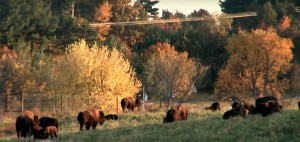Dixon’s Nachusa Grasslands is a 3,500-acre living laboratory
Chronicle Media — January 4, 2016

Bison graze at the 3,500-acre Nachusa Grasslands preserve near Dixon, a site operated by The Nature Conservancy, a non-profit conservation organization.
World-renowned for its restoration strategies, the Nachusa Grasslands preserve near Dixon, Ill., just a 45-minute drive from the NIU campus, provides a rare and stunning reminder of what the “Prairie State” looked like once upon a time—complete with bison roaming its grasslands.
It also is providing a 3,500-acre living laboratory with unparalleled research opportunities for NIU scientists and students.
NIU research efforts ramped up substantially a year ago with the reintroduction of the shaggy behemoths of the Great Plains, which once numbered in the tens of millions nationwide before becoming nearly extinct.
The accompanying video highlights the work of biological sciences major Maria Weston, who is studying the effects of bison-wallowing on the seed-eating habits of insects and small mammals.
While Illinois is officially known as the Prairie State, the sad irony is that 99.9 percent of its prairie has been lost to agriculture and development, says NIU professor Holly Jones, who holds a joint appointment with biological sciences and NIU’s Institute for the Study of the Environment, Sustainability, and Energy.
bisonOwned and operated by The Nature Conservancy, a nonprofit conservation organization, Nachusa Grasslands demonstrates how prairies can make a comeback.
“Nachusa is reintroducing bison to help regain the ecosystem function lost in their absence,” Jones says. “Native grazers such as bison historically helped maintain prairie, but they were driven to near-extinction through hunting, agriculture and development.”
Experts believe the Nachusa bison will further restore the prairie’s biodiversity. For example, a landscape with a patchwork of both grazed and ungrazed areas provides habitat for more species of birds. Wallows created by bison tend to puddle during springtime and create breeding areas for amphibians. Insects feed off bison dung, expand their populations and become meals for birds and other small animals.
Scientists want to know more about this web of life.
“We know a lot about how vegetation does under prairie restoration and management with bison grazing, but we have very little information on how animals respond,” Jones says. “This is the first time bison have been reintroduced to restored prairie, so our research will for the first time document the effects of bison restoration on animal communities that are themselves responding to plant restoration.”
Jones’ NIU laboratory is conducting studies on how the bison’s presence will effect populations of grassland birds, small mammals and deer. She has five undergraduate and three graduate students working on projects.
— Dixon’s Nachusa Grasslands is a 3,500-acre living laboratory —



